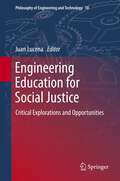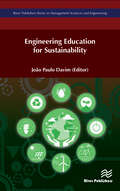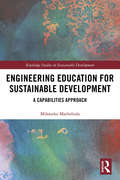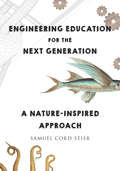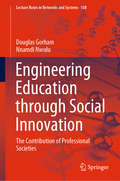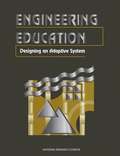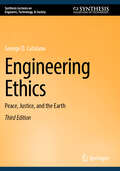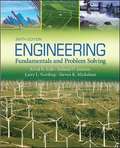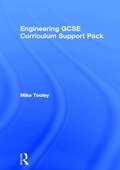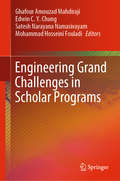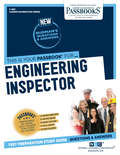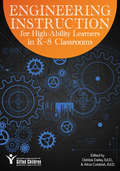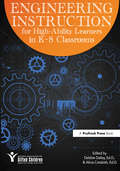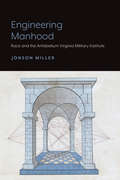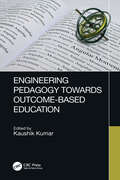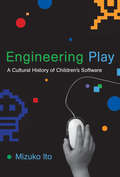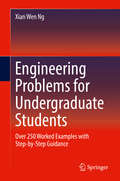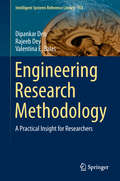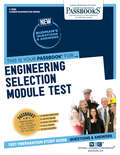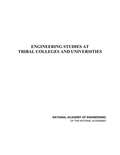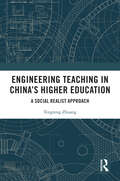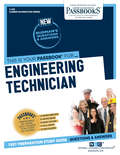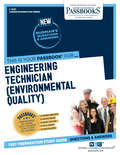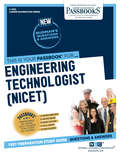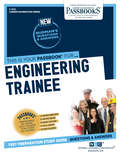- Table View
- List View
Engineering Education for Social Justice: Critical Explorations and Opportunities
by Juan LucenaHoping to help transform engineering into a more socially just field of practice, this book offers various perspectives and strategies while highlighting key concepts and themes that help readers understand the complex relationship between engineering education and social justice. This volume tackles topics and scopes ranging from the role of Buddhism in socially just engineering to the blinding effects of ideologies in engineering to case studies on the implications of engineered systems for social justice. This book aims to serve as a framework for interventions or strategies to make social justice more visible in engineering education and enhance scholarship in the emerging field of Engineering and Social Justice (ESJ). This creates a 'toolbox' for engineering educators and students to make social justice a central theme in engineering education.
Engineering Education for Sustainability
by João Paulo DavimUnderstood to be a key issue in modern society, sustainability is characterized by its three essential pillars, namely: the environment, society and the economy. Education plays an important role in how people understand and accept sustainability. The integration of sustainability in engineering education is a relatively new phenomenon, and presenting information about engineering education for sustainability is of great interest to improve communication between professors, researchers and students at universities, institutes and research laboratories.Topics discussed in the book include: Experiences from 5 years of educating sustainability to computer science students Review of decision support methods in green and sustainable supply chains Analyzing the drivers of engineering education for sustainability using the MCDM approach Visualization technologies in construction education: a comprehensive review of recent advances A legal framework and compliance with construction safety laws and regulations
Engineering Education for Sustainable Development: A Capabilities Approach (Routledge Studies in Sustainable Development)
by Mikateko MathebulaThis book demonstrates how the theoretical concepts of the capabilities approach can be applied in the context of engineering education, and how this could be used to add nuance to our understanding of the contribution higher education can make to human flourishing. In demonstrating the usefulness of the capability approach as a lens through which to evaluate the outputs of engineering education, the author also shows how the capability approach can be informed by, and informs, the concept of ‘sustainable development’ and discusses what pedagogical and curricula implications this may have for education for sustainable development (ESD), particularly in engineering. As such, the book builds on the work of scholars of engineering education, and scholars of university education at the nexus of development and sustainability. Engineering employers, educators and students from diverse contexts discuss both the capabilities and functions that are enlarged by engineering education and the impact these can have on pro-poor engineering or public-good professionalism. The book therefore makes an original conceptual and empirical contribution to our thinking about engineering education research. The book provides inspiration for both engineering educators and students to orient their technical knowledge and transferable skills towards the public good. It will also be of great interest to students and researchers interested in education for sustainable development more generally and to engineers who are interested in doing work that is aligned with the goals of social justice. The book will also appeal to scholars of the capability approach within higher education.
Engineering Education for the Next Generation: A Nature-inspired Approach
by Samuel Cord StierGuide your students through the fascinating world of engineering, and how to draw inspiration from Nature’s genius to create, make, and innovate a better human-built world. Studded with more than 150 illustrations of natural phenomena and engineering concepts, this fascinating and practical book clearly demonstrates how engineering design is broadly relevant for all students, not just those who may become scientists or engineers. Mr. Stier describes clever, engaging activities for students at every grade level to grasp engineering concepts by exploring the everyday design genius of the natural world around us. Students will love learning about structural engineering while standing on eggs; investigating concepts in sustainable design by manufacturing cement out of car exhaust; and coming to understand how ant behavior has revolutionized the way computer programs, robots, movies, and video games are designed today. You will come away with an understanding of engineering and Nature unlike any you’ve had before, while taking your ability to engage students to a whole new level. Engineering Education for the Next Generation is a wonderful introduction to the topic for any teacher who wants to understand more about engineering design in particular, its relation to the larger subjects of STEM/STEAM, and how to engage students from all backgrounds in a way that meaningfully transforms their outlook on the world and their own creativity in a lifelong way. · Fun to read, comprehensive exploration of cutting-edge approaches to K-12 engineering education · Detailed descriptions and explanations to help teachers create activities and lessons · An emphasis on engaging students with broad and diverse interests and backgrounds · Insights from a leading, award-winning K-12 engineering curriculum that has reached thousands of teachers and students in the U.S. and beyond · Additional support website (www.LearningWithNature.org) providing more background, videos, curricula, slide decks, and other supplemental materials
Engineering Education through Social Innovation: The Contribution of Professional Societies (Lecture Notes in Networks and Systems #108)
by Douglas Gorham Nnamdi NwuluThis book explores the nexus between professional technical societies and engineering education by examining several societies’ efforts to promote and support engineering and engineering education in the areas of pre-university education, university education and informal education through programs and activities designed to leverage social innovation. Professional societies are in a unique position to support and contribute to engineering education, and have dedicated substantial resources to social responsibility programs and activities that promote engineers and engineering. The book is chiefly intended for engineers, engineering educators, staff members of professional technical societies, and for the broad range of scholars whose work involves technology education and education policy.
Engineering Education: Designing an Adaptive System
by Board on Engineering EducationTraditionally, engineering education books describe and reinforce unchanging principles that are basic to the field. However, the dramatic changes in the engineering environment during the last decade demand a paradigm shift from the engineering education community. This revolutionary volume addresses the development of long-term strategies for an engineering education system that will reflect the needs and realities of the United States and the world in the 21st century. The authors discuss the critical challenges facing U.S. engineering education and present a plan addressing these challenges in the context of rapidly changing circumstances, technologies, and demands.
Engineering Ethics: Peace, Justice, and the Earth (Synthesis Lectures on Engineers, Technology, & Society)
by George D. CatalanoIn the original two editions of Engineering Ethics: Peace, Justice, and the Earth, a response of the engineering profession to the challenges of security, poverty and underdevelopment, environmental sustainability, and native cultures was described. Ethical codes, which govern the behavior of engineers, were examined from a historical perspective linking the prevailing codes to models of the natural world. A new ethical code based on a recently introduced model of Nature as an integral community was provided and discussed. Applications of the new code were described using a case study approach. The proposed third edition will build on the foundational material included in the previous two editions. Over the course of the last decade new and profoundly challenging ethical issues (synthetic biology, artificial intelligence, climate change and the sixth extinction) have arisen in the engineering profession. The notion of an integral community has been more fully developed. The proposed book will include an exploration of these issues as well as provide the reader with a better understanding of the historical development of ethical reasoning and consider future possibilities. Implications of the innovative ideas in ethics and design on engineering education are also considered.
Engineering Fundamentals and Problem Solving
by Arvid R. Eide Roland Jenison Steven Mickelson Larry L. NorthupEngineering Fundamentals & Problem Solving is written to motivate engineering students during their first year. A complete introduction to the engineering field, this text will help students develop the skills to solving open-ended problems in SI and customary units while presenting solutions in a logical manner. Eide introduces students to subject areas that are common to engineering disciplines that require the application of fundamental engineering concepts. Engineering Fundamentals & Problem Solving remains the most comprehensive text for an introductory engineering course. The book provides students a realistic opportunity to learn to apply engineering principles to the solution of engineering problems, and the author's approach keeps students on task toward an engineering career by showing how the materials applies to the student's school, life, and career. While not every course will cover all the topics in this text, McGraw-Hill is proud to offer Create, which will allow you to select the material you need from this text and many others in our B. E. S. T. series for freshman engineering so you can creat materials exactly suited to your course. For more information, please go to the Create website or contact your sales representative.
Engineering GCSE Curriculum Support Pack
by Mike TooleyUsed alongside the textbook Engineering GCSE, this pack offers a complete course for the new GCSE syllabuses from Edexcel and OCR, providing all the resources needed by a busy teacher or lecturer as well as a student-centred learning programme that will enable students to gain the skills, knowledge and understanding they require.The photocopiable materials in this pack include:* Background to running a GCSE Engineering course* Worksheets to support and develop work in the textbook* Assignments, practicals and design briefs* Reference material and revision sheets for use as handoutsThis pack builds on the success of Mike Tooley's GNVQ materials, which have helped thousands of students to gain their first engineering qualification.Mike Tooley is Vice Principal at Brooklands College, Surrey, and author of many engineering and electronics books.
Engineering Grand Challenges in Scholar Programs
by Ghafour Amouzad Mahdiraji Edwin C.Y. Chung Satesh Narayana Namasivayam Mohammad Hosseini FouladiThis book explains how Taylor’s University implemented a curriculum in their engineering program that prepares students to address challenges facing the world. Aim is to enable Engineers put their knowledge into application to meet the 14 challenges of the century as outlined by the National Academy of Engineering (NAE) of the United States. The research groups are organized around the 14 grand challenges for engineering The structure of their syllabi is organized in a way that they address the 5 core competencies: Research Experience, Entrepreneurship, Service Learning, Interdisciplinary Curriculum, Global Dimension. It uses the CDIO educational framework, a project-based learning approach that provides students with the big picture of engineering. Through this method, students are able to: Master a deeper working knowledge of the fundamentals of engineering Lead in the creation and operation of new products and systems Understand the importance and strategic value of research work As the only programe of its kind outside North America, it offers the brightest minds the opportunity to face real-world issues and places them on the cutting edge of the engineering world.
Engineering Inspector: Passbooks Study Guide (Career Examination Series)
by National Learning CorporationThe Engineering Inspector Passbook® prepares you for your test by allowing you to take practice exams in the subjects you need to study. It provides hundreds of questions and answers in the areas that will likely be covered on your upcoming exam.
Engineering Instruction for High-Ability Learners in K-8 Classrooms
by Alicia Cotabish Debbie DaileyEngineering Instruction for High-Ability Learners in K-8 Classrooms is an application-based practitioners' guide to applied engineering that is grounded in engineering practices found in the new Next Generation Science Standards (NGSS) and the Standards for Engineering Education. The book will provide educators with information and examples on integrating engineering into existing and newly designed curriculum. The book will specify necessary components of engineering curriculum and instruction, recommend appropriate activities to encourage problem solving, creativity, and innovation, and provide examples of innovative technology in engineering curriculum and instruction. Additionally, authors will discuss professional development practices to best prepare teachers for engineering instruction and provide recommendations to identify engineering talent among K-8 students. Finally, the book will include a wealth of resources, including sample lesson and assessment plans, to assist educators in integrating engineering into their curriculum and instruction.
Engineering Instruction for High-Ability Learners in K-8 Classrooms
by Alicia Cotabish National Assoc For Gifted ChildrenEngineering Instruction for High-Ability Learners in K-8 Classrooms is an application-based practitioners' guide to applied engineering that is grounded in engineering practices found in the new Next Generation Science Standards (NGSS) and the Standards for Engineering Education. The book provides educators with information and examples on integrating engineering into existing and newly designed curriculum. The book specifies necessary components of engineering curriculum and instruction, recommends appropriate activities to encourage problem solving, creativity, and innovation, and provides examples of innovative technology in engineering curriculum and instruction. Additionally, authors discuss professional development practices to best prepare teachers for engineering instruction and provide recommendations to identify engineering talent among K-8 students. Finally, the book includes a wealth of resources, including sample lesson and assessment plans, to assist educators in integrating engineering into their curriculum and instruction.
Engineering Manhood: Race and the Antebellum Virginia Military Institute
by Jonson MillerIt is not an accident that American engineering is so disproportionately male and white; it took and takes work to create and sustain this situation. Engineering Manhood: Race and the Antebellum Virginia Military Institute examines the process by which engineers of the antebellum Virginia Military Institute cultivated whiteness, manhood, and other intersecting identities as essential to an engineering professional identity. VMI opened in 1839 to provide one of the earliest and most thorough engineering educations available in antebellum America. The officers of the school saw engineering work as intimately linked to being a particular type of person, one that excluded women or black men. This particular white manhood they crafted drew upon a growing middle-class culture. These precedents impacted engineering education broadly in this country and we continue to see their legacy today.
Engineering Pedagogy Towards Outcome-Based Education
by Kaushik KumarWith the growing environment and consciousness of "outcome-based education," the importance of this subject has increased manyfold. Unfortunately, there is little information on engineering pedagogy available outside of scattered journal articles, conference and symposium proceedings, workshop notes, and government and company reports. This book overcomes these difficulties by presenting, in a single volume, many of the recent advances in the field of engineering pedagogy and its recent developments. Engineering Pedagogy Towards Outcome-Based Education provides a systematic approach to explicit fundamentals as well as recent advances in the area. It incorporates various case studies for major topics as well as numerous academic examples. Each chapter contains many state-of-the-art techniques required for practical engineering applications. This book serves as a useful source of information for practicing academicians and specialists as well as academic institutions working on the subject.
Engineering Play: A Cultural History of Children's Software (The John D. and Catherine T. MacArthur Foundation Series on Digital Media and Learning)
by Mizuko ItoHow the influential industry that produced such popular games as Oregon Trail and KidPix emerged from experimental efforts to use computers as tools in child-centered learning.Today, computers are part of kids' everyday lives, used both for play and for learning. We envy children's natural affinity for computers, the ease with which they click in and out of digital worlds. Thirty years ago, however, the computer belonged almost exclusively to business, the military, and academia. In Engineering Play, Mizuko Ito describes the transformation of the computer from a tool associated with adults and work to one linked to children, learning, and play. Ito gives an account of a pivotal period in the 1980s and 1990s, which saw the rise of a new category of consumer software designed specifically for elementary school-aged children. “Edutainment” software sought to blend various educational philosophies with interactive gaming and entertainment, and included such titles as Number Munchers, Oregon Trail, KidPix, and Where in the World Is Carmen Sandiego?.The children's software boom (and the bust that followed), says Ito, can be seen as a microcosm of the negotiations surrounding new technology, children, and education. The story she tells is both a testimonial to the transformative power of innovation and a cautionary tale about its limitations.
Engineering Problems for Undergraduate Students: Over 250 Worked Examples with Step-by-Step Guidance
by Xian Wen NgThis textbook supplement deconstructs some of the most commonly-encountered and challenging problems arising within engineering domains such as thermodynamics, separation processes, chemical kinetics, fluid dynamics, and engineering mathematics that are foundational to most engineering programs, as well as many courses in STEM disciplines. The book is organized into a series of 250 problems and worked solutions, with problems written in a format typical of exam questions. The book provides students ample practice in solving problems and sharpening their skill applying abstract theoretical concepts to solving exam problems. The presentation of detailed step-by-step explanations for each problem from start to finish in this book helps students follow the train of thought toward arriving at the final numerical solutions to the problems.Stands as an all-in-one, multidisciplinary, engineering problem-solving resource with comprehensive depth and breadth of coverage;Adopts a highly relevant question and answer pedagogy;Maximizes understanding through clear use of visuals;Emphasizes detailed, step-by-step explanations;Includes supplementary sections of cross-referenced concepts.
Engineering Research Methodology: A Practical Insight For Researchers (Intelligent Systems Reference Library #153)
by Rajeeb Dey Valentina E. Balas Dipankar DebThe book covers all the important aspects of research methodology, and addresses the specific requirements of engineering students, such as methods and tools, in detail. It also discusses effective research in engineering today, which requires the ability to undertake literature reviews utilizing different online databases, to attribute credit for any prior work mentioned, to respect intellectual property rights while simultaneously maintaining ethics in research, and much more. Further, the book also considers soft skills like research management and planning, dealing with criticism in research and presentation skills, which are all equally important and need to include in research methodology education. Lastly, it provides the technical knowhow needed to file patents in academia, an important area that is often ignored in research methodology books. The book is a particularly valuable resource for PhD students in India and South East Asia, as research methodology is a part of their coursework.
Engineering Selection Module Test: Passbooks Study Guide (Career Examination Series)
by National Learning CorporationThe Engineering Selection Module Test Passbook® prepares you for your test by allowing you to take practice exams in the subjects you need to study. It provides hundreds of questions and answers in the areas that will likely be covered on your upcoming exam.
Engineering Studies At Tribal Colleges And Universities
by National Academy of Engineering of the National AcademiesThis study was designed to provide expert, objective, independent advice to 11 tribal colleges that are working together to offer engineering programs. The chief data-gathering activity was a one and one-half day workshop. Reasons for establishing a four-year engineering program at a TCU were outlined in the workshop—making it possible for American Indian students to complete a four-year engineering degree entirely within the tribal college system; reducing the high attrition rate of American Indian students who attend mainstream educational institutions; and providing an engineering program that is culturally relevant to tribal students.
Engineering Teaching in China’s Higher Education: A Social Realist Approach
by Tengteng ZhuangBased on a case study of engineering teaching in China’s higher education sector, this book unravels the interlocking influencing factors that condition the experience of engineering faculty members along with multiple stakeholders’ expectations of engineering teaching.What motivates and demotivates a university instructor to provide excellent teaching, especially in the disciplines where effective instructor guidance is crucial for student learning? This book gives evidence-based answers to this research question, drawing upon a social realist framework in relation to the disciplinary features of engineering and based on both qualitative and quantitative methods. It expatiates upon structural, cultural, and reflexive factors concerning both the academic profession and industry and how teaching behaviors are shaped. In doing so, the author advances pragmatic suggestions for higher education reform under the prevalent performance management systems, posing implications for global higher education in regard to what structural arrangements and cultural milieu should be in place to unleash the potential of engineering teaching.The book will appeal to scholars of higher education, Chinese and comparative education, and education sociology, and academics and policy-makers interested in engineering education and teacher education.
Engineering Technician: Passbooks Study Guide (Career Examination Series #C-248)
by National Learning CorporationThe Engineering Technician Passbook® prepares you for your test by allowing you to take practice exams in the subjects you need to study. It provides hundreds of questions and answers in the areas that will likely be covered on your upcoming exam.
Engineering Technician: Passbooks Study Guide (Career Examination Series #C-248)
by National Learning CorporationThe Engineering Technician (Environmental Quality) Passbook® prepares you for your test by allowing you to take practice exams in the subjects you need to study. It provides hundreds of questions and answers in the areas that will likely be covered on your upcoming exam.
Engineering Technologist: Passbooks Study Guide (Career Examination Series)
by National Learning CorporationThe Engineering Technologist (NICET) Passbook® prepares you for your test by allowing you to take practice exams in the subjects you need to study. It provides hundreds of questions and answers in the areas that will likely be covered on your upcoming exam.
Engineering Trainee: Passbooks Study Guide (Career Examination Series #C-945)
by National Learning CorporationThe Engineering Trainee Passbook® prepares you for your test by allowing you to take practice exams in the subjects you need to study. It provides hundreds of questions and answers in the areas that will likely be covered on your upcoming exam.
